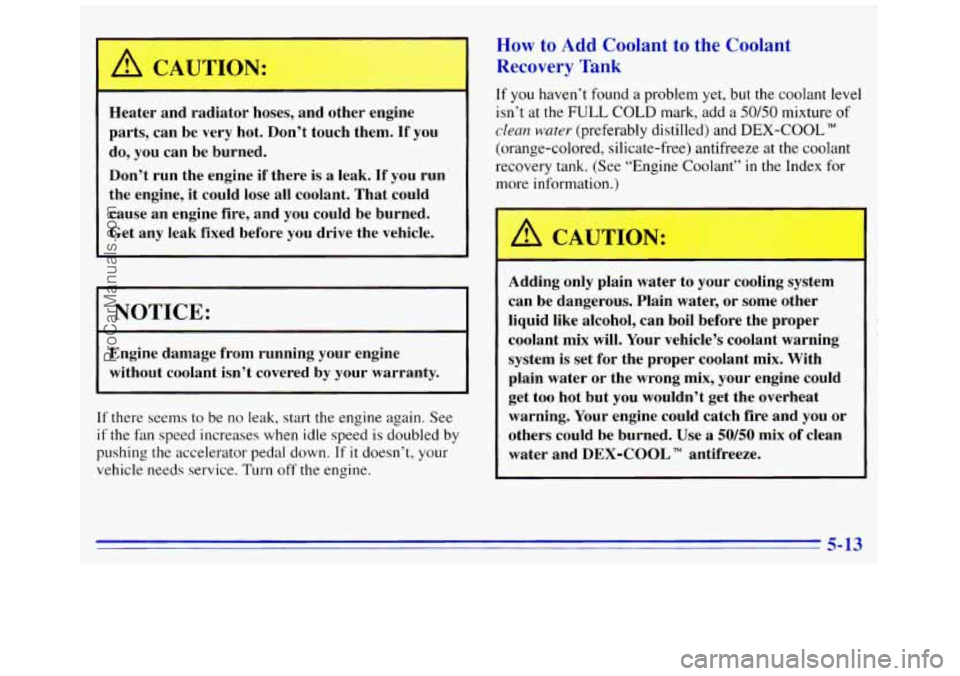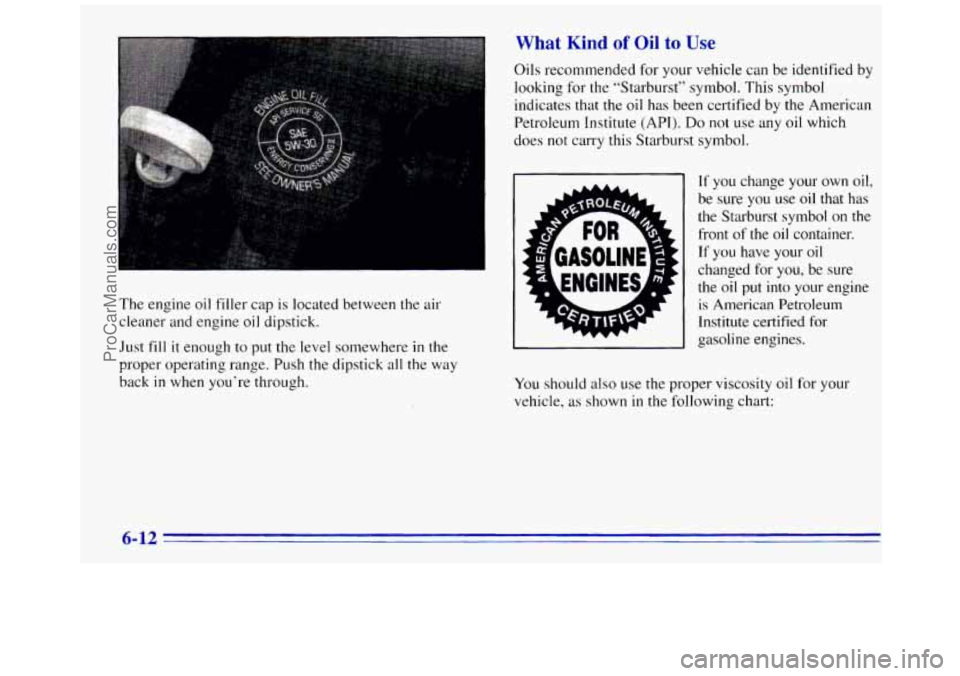1996 GMC SAVANA oil level
[x] Cancel search: oil levelPage 110 of 372

Oil Pressure Gage
The oil pressure gage shows the engine oil
pressure in psi (pounds
per square inch) when the engine is running. Canadian
vehicles indicate pressure
Oil pressure may vary with engine speed, outside
temperature and oil viscosity,
but readings above
the
lowpressure zone indicate the normal operating range.
A reading in the low pressure zone may be caused by a
dangerously low oil level or other problem causing low
oil pressure. Check'your oil as
soon as possible.
Don't keep driving if the oil pressure is low. If
you do, your engine can become so hot that it
catches fire. You or others could be burned.
Check your oil
as soon as possible and have your.
vehicle serviced.
I
I
NOTICE: '1 ~
Damage to your engine from neglected oil
problems can be costly and
is not covered by
your warranty.
ProCarManuals.com
Page 168 of 372

Once you are moving on the freeway, make certain
you allow a reasonable following distance. Expect to
move slightly slower at night.
When you want to leave
the freeway, move to the
proper lane well
in advance. If YOLI miss your exit, do
not, under any circumstances, stop and back up. Drive
on
to the next exit.
The exit ramp can be curved, sometimes quite sharply.
The exit speed is usually posted. Reduce your speed according
to your speedometer, not
to your sense of motion. After driving for any distance
at higher speeds,
you may tend to think you are going
slower than you actually are.
Before Leaving on a Long Trip
Make sure you’re ready. Try to be well rested. If you
must start when you’re not fresh
-- such as after a day’s
work
-- don’t plan to make too many miles that first part
of
the journey. Wear comfortable clothing and shoes you
can easily drive
in.
Is your vehicle ready for a long trip? If you keep it
serviced and maintained, it’s ready to go. If it needs
service, have it done before starting
out. Of course,
you’ll find experienced and able service experts
in GM
dealers
all across North America. They’ll be ready and
willing to help
if you need it.
Here are some things you can check before a trip:
0
0
0
0
0
0
0
Windshield Wclsher Fluid: Is the reservoir full? Are
all windows clean inside and outside?
Wiper- Blcrdes: Are they in good shape?
Fuel, Engine Oil, Other FlLtids: Have you checked
all levels?
Lnlnps: Are they all working? Are the lenses clean?
Tires: They are vitally important to a safe,
trouble-free trip.
Is the tread good enough for
long-distance driving? Are
the tires all inflated to the
recommended pressure?
Weather Forecasts: What’s the weather outlook
along your route‘? Should you delay your trip a short
time
to avoid a major storm system?
Maps: Do you have up-to-date maps‘?
4-20
ProCarManuals.com
Page 184 of 372

Driving On Grades
Reduce speed and shift to a:lower gear before you start
down a long or steep doyngrade. If you don’t shift
down, you might have to use your brakes
so much that
they would get hot and no longer work well.
On a long uphill grade, shift down and reduce your
speed to around
45 mph (70 km/h) to reduce the
possibility
of engine and transmission overheating.
When towing at high altitude on steep uphill grades,
consider the following: Engine coolant will boil at a
lower temperature than
at normal altitudes. If you turn
your engine
off immediately after towing at high altitude
on steep uphill grades,
your vehicle may show signs
similar to engine overheating.
To avoid this, let the
engine run while parked (preferably on level ground)
with the automatic transmission in PARK
(P) for a few
minutes before turning the engine off.. If
you do get the
overheat warning, see “Engine Overheating” in the Index.
Parking on.Hills
You really should not park your vehicle, with a trailer
attached, .on a hill.
If something goes wrong, your rig
could start
to move. People can be injured, and both
your vehicle and the trailer can be damaged.
But if you ever have to park your rig on a hill, here’s
how to do it:
1. Apply your regular brakes, but don’t shift into
PARK
(P) yet. Then turn your wheels into the curb
if facing downhill or into traffic if facing ,uphill.
2. Have someone place chocks under the trailer wheels. I
3. When the wheel chocks are in place, release the
regular brakes until the chocks absorb the load.
4. Re-apply the regular brakes. Then apply your
parking brake and then shift to
PARK (P).
5. Release the regular brakes.
ProCarManuals.com
Page 200 of 372

’
Cooling System
When you decide it’s safe to lift the hood, here’s what
you’ll see:
A. Radiator Pressure Cap
B. Coolant Recovery Tank
C. Engine Fan(s)
If the coolant inside the coolant recovery tank is boiling,
don’t
do anything else until it cools down.
The coolant level should
be at or above the FULL
COLD mark.
If it isn’t, you may have a leak in the
radiator hoses, heater hoses, radiator, water pump or
somewhere else in the cooling system.
i
7 ’ :5-12
ProCarManuals.com
Page 201 of 372

A CAUTIO1 . .
Heater and radiator hoses, and other engine
parts, can be very hot. Don’t touch them. If you
do,
you can be burned.
Don’t run the engine if there is a leak. If you run
the engine, it could lose all coolant. That could
cause an engine fire, and you could be burned.
Get any leak fixed before you drive the vehicle.
I NOTICE:
Engine damage from running your engine
without coolant isn’t covered by your warranty.
~~ ~ ~
If there seems to be no leak, start the engine again. See
if the fan speed increases when idle speed is doubled by
pushing
the accelerator pedal down. If it doesn’t, your
vehicle needs service. Turn
off the engine.
How to Add Coolant to the Coolant
Recovery Tank
If you haven’t found a problem yet, but the coolant level
isn’t at the
FULL COLD mark, add a 50150 mixture of
clean water (preferably distilled) and DEX-COOL
(orange-colored, silicate-free) antifreeze at the coolant
recovery tank. (See “Engine Coolant”
in the Index for
more information.)
Adding only plain water
to your cooling system
can be dangerous. Plain water, or some other
liquid like alcohol, can boil before the proper
coolant mix will. Your vehicle’s coolant warning
system is set for the proper coolant mix. With
plain water or the wrong mix, your engine could
get too hot but you wouldn’t get the overheat
warning. Your engine could catch fire and you or
others could be burned. Use
a 50/50 mix of clean
water and DEX-COOL
TM antifreeze.
5-13
ProCarManuals.com
Page 235 of 372

Engine Oil (Gasoline Engine)
If your vehicle has a diesel engine, see “Engine Oil
(Diesel Engine)” in the Diesel Engine Supplement.
It‘s
a good idea to check your engine oil every time you
be warm and the vehicle must be on level ground.
c‘ Get fuel. In order to get an accurate reading, the oil must
Turn
off the engine and give
the oil
a few minutes to drain
back into the
oil pan. If you
don’t, the oil dipstick might
not show the actual level.
Checking Engine Oil
Pull out the dipstick and clean it with a paper towel or
cloth, then push
it back in all the way. Remove it again,
keeping the tip down, and check the level.
When to Add Oil
If the oil is at or below the ADD mark, then ~011’11 need to
add some oil. But you must use the right kind. This part
explains what kind
of oil to use. For crankcase capacity,
see “Capacities and Specifications”
in the Index.
NOTICE:
Don’t add too much oil. If your engine has so much
oil that the oil level gets above the upper mark that
shows the proper operating range, your engine could be damaged.
ProCarManuals.com
Page 236 of 372

What Kind of Oil to Use
The engine oil filler cap is located between the air
cleaner and engine oil dipstick.
Just
fill it enough to put the level somewhere in the
proper operating range. Push the dipstick all the way
back
in when you’re through. Oils recommended
for your vehicle can be identified
by
looking for the ”Starburst” symbol. This symbol
indicates that the oil
has been certified by the American
Petroleum Institute
(API). Do not use any oil which
does not carry this Starburst symbol.
If you change your own oil,
be sure you use
oil that has
the Starburst symbol on
the
front of the oil container.
If you have your
oil
changed for you, be sure
the
oil put into your engine
is American Petroleum
Institute certified for
gasoline engines.
You should also use the proper viscosity oil for your
vehicle,
as shown in the following chart:
6-12
ProCarManuals.com
Page 240 of 372

Automatic Transmission Fluid
7 ’ ~ n to Check and Change
A good time to check your automatic transmission fluid
level is when the engine oil is changed.
Change
both the fluid and filter every 50,000 miles
(83 000 km) if the vehicle’s GVWR is over 8,600 or
if
the vehicle is mainly driven under one or more of
these conditions:
0 In heavy city traffic where the outside temperature
0 In hilly or mountainous terrain.
0 When doing frequent trailer towing.
regularly
reaches
90°F (32°C) or higher.
0 Uses such as found in taxi, police or delivery service.
If your vehicle’s GVWR is not over 8,600 and you do
not use your vehicle under any of these conditions, the
fluid and filter do not require changing.
See “Scheduled Maintenance Services”
in the Index.
How to Check
Because this operation can be a little difficult, you
may choose to have this done at your GM dealer
Service Department.
If you do it yourself, be sure to follow all the
instructions here, or you could get
a false reading on
the dipstick.
NOTICE:
Too much or too little fluid can damage your
transmission.
Too much can mean that some of
the fluid could come out and fall on hot engine parts or exhaust system parts, starting a fire. Be
sure to get an accurate reading if you check your
transmission fluid.
ProCarManuals.com